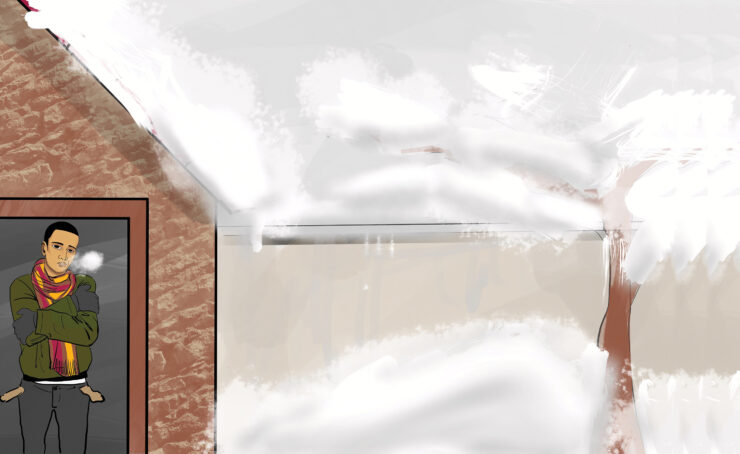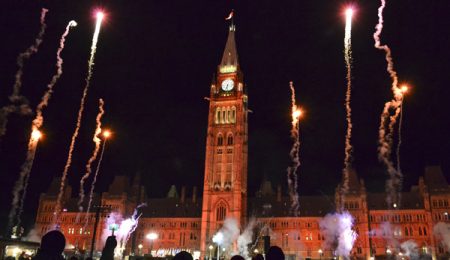Is the cap and trade system going to make our lives better, or just make it more expensive?
On Jan. 1, as Ontario residents woke up from celebrating the New Year, few may have realized that the cost of living increased overnight. Not only did gas prices rise by 4.3 cents per litre, but hydro bills and shopping bills will soon see an increase as well.
These changes come as a result of Premier Kathleen Wynne’s adoption of a cap and trade system, which the Ontario government passed in May of 2016. The implementation of this regulatory system was Wynne’s answer to the federal government’s call to combat climate change.
Canada’s dedication to counteract this environmental phenomena began when Prime Minister Justin Trudeau joined the global effort in Paris last spring, after a number of failed attempts at capping Canada’s emissions.
“Canada, federally, went to Paris and signed the Paris agreement,” said Cherie Wong, co-chair of the Young Greens of Canada. “That was to make sure the global temperature increase is below two degrees every year and making all the countries who signed it accountable to the greenhouse gases level.”
The government’s commitment to stop global warming stood as a signal that further change was coming for our country, whether that be at a federal or provincial level.
But is cap and trade really an efficient way to combat climate change, and how will this system affect Ontarians in the long run?
What’s the fuss over climate change?
According to 2016 report from the federal government, Canada’s production of greenhouse gases has grown by as much as 47 per cent between 1990 and 2012. And despite only having 0.5 per cent of the world’s population, we contribute to 1.6 per cent of the world’s greenhouse gas emissions.
For U of O psychology student and environmental activist Rae McDole, the consequences of climate change are now too big to ignore.
“We’re seeing the consequences, we’re seeing the rising sea levels, the rising temperature levels, soil erosion, and all these different things that have a dramatic impact,” said McDole. “The whole planet is deteriorating, from species extinction to ecosystems being destroyed.”
Canada’s specific goal is “reducing our emissions by 30 per cent by 2030,” said the U of O public and international affairs associate professor Nicholas Rivers.
In order to achieve the goals set in Paris, the federal government unveiled a pan-Canadian framework, in which, as Rivers explained, “every province must put a price on carbon, but the provinces decide how they want to do it.”
Ontario’s Liberal government decided to price carbon in the form of a cap and trade system. While these words have been floating around for almost a year now, what does this system actually entail?
“The cap and trade program limits the total amount of carbon dioxide and other greenhouse gases that can be produced in Ontario,” explains Rivers. “Companies that sell natural gas and gasoline have to hold permits and remit them to the government to cover all the carbon dioxide emissions that are going to be produced by the natural gas and gasoline.”
The government hopes that limiting the amount of greenhouse gases that companies are allowed to emit will create incentives for companies to go green. Every year the limit is lowered, thus reducing carbon emissions.
The trade portion of the system works by allowing companies to trade carbon allowances. These allowances determine the amount of carbon a company is permitted to produce.
This is slightly different than the carbon tax system that the Alberta government just adopted, which focuses on price instead of quantity.
Political controversy
Even though the cap and trade system has been designed to address climate change, it has been met with hesitation from people across the political spectrum.
For Wong and other Green Party members, this system may not be enough.
“The Green Party believes there is much growth to the number we can commit to for the global increase. The Liberal government’s goal is a brave goal, but not enough.”
Ontario’s Conservative Party leader Patrick Brown has also expressed opposition to this system, announcing in a letter to the public that he believes this cap and trade system is more of a money grab than it is about the environment.
Despite the differences of opinions, Wong notes that instituting cap and trade is a step in the right direction.
“The fact that the Liberal government set this limit and agreed to the Paris agreement is more than the Harper government did. For that, we are thankful.”
What’s the cost?
According to Wynne’s government, the cap and trade system is estimated to generate $1.9 billion per year.
These funds will then be used to “invest in clean energy technology and research,” said Wong.
She further explained that this may take the form of “new transit, because the government thinks that we need to move out of the fossil fuel age and move into renewable energy.”
In order to generate this revenue, the cost of living will increase for Canadian consumers.
Rivers suggests that these increased costs are due to companies now having to purchase permits in order to emit greenhouse gases.
“These permits have a cost, so the companies that sell us natural gas and the companies that sell us gasoline are going to pass some of that cost, or all of that cost, on to us as consumers,” he said.
“It will increase our gas bills by maybe 6–10 per cent. And you can see the price of gasoline has gone up as well, about five cents a litre.”
Wong notes that this may be problematic for students.
“For students, carbon pric(ing) will cause us to live more expensively. However, students usually want cheap and easy.”
Hydro is estimated to cost about $156 more per year. Other goods and services will increase as well, costing students at least $75 more a year.
Rivers suggests that students may face another problem in the coming months.
“I think one of the things we don’t know about yet is how landlords might pass through the costs,” she said. “Say you’re a student, you’re renting a place and you don’t pay your energy costs. Are the landlords going to put the rent up or are they going to absorb the cost? We don’t really know the answer to that question.”
Not only are students being impacted by these cap and trade costs, but those who have families living in rural communities may be at a greater disadvantage.
For fourth-year political science student Matthew Don Trapp and his family, living in a rural community has added extra costs that city dwellers might not see.
“I live in Dorchester, Ontario, in the country. It’s between Dorchester and London so the hydro lines run right between the two. The people in town don’t pay rural delivery rates and the city doesn’t pay rural delivery rates. It’s the same line, but because we are in between we pay rural delivery rates. Even though there’s no increase in cost to the provider with the infrastructure.”
In fact, those in rural communities will see a 25 per cent increase in delivery charges, while their urban counterparts will see a slight decrease in delivery charges.
But Jamie Benidickson, an environmental law professor from the U of O, insists that the disadvantages faced by rural communities are not being ignored.
“Rural residents often rely on wood stoves, so the government has said these people need to be encouraged to participate in an overall climate change response, but they shouldn’t face a heavy penalty,” he said. “So maybe we need to find ways to subsidize high efficiency wood burning stoves in rural areas.”
Another implication of high delivery rates for rural residents is that some may feel forced to relocate to subsidize the costs. Don Trapp posits that “People living in rural communities are basically being told to move into the city.”
In response to these concerns raised by rural residents, Wynne is considering the possibility of eliminating delivery charges, which can make up approximately 30 per cent of a hydro bill for those in rural areas. However, no plans have been finalized as of yet.
Rivers explains that cap and trade may also disproportionately impact disadvantaged groups like low-income families.
“In most developed countries, you find that as a per-portion of their income, people at the low end of the income spectrum spend more on gasoline and natural gas than people in the high end of the income spectrum. So that means if the price of natural gas and gasoline goes up, they are likely to face a higher cost as a percentage of their income.”
While these price increases seem troubling, there is some good news.
With the money generated from the cap and trade program, Wynne’s government is reinvesting the money into initiatives that Rivers suggests may benefit students.
“Ontario has taken the money to develop new energy efficiency programs and greenhouse gas reduction programs that students may benefit from. Part of the funds are going to be used to update the efficiency of buildings, such as housing, and so that could be something that benefits students.”
Benefit to the environment?
As Ontario residents figure out how to manage the extra costs, many are left wondering if these efforts will even reduce emissions in the first place.
Unfortunately, there is no easy answer to that question and it will take time to see how exactly cap and trade will affect Canada’s greenhouse gas emissions.
Rivers acknowledges that while carbon pricing is an effective method of achieving lower emissions, they may not be enough.
“At least at a cursory level the policies we’ve implemented are not strong enough to get us all the way to our Paris goals,” said Rivers.
The most troubling concern over Canadian greenhouse gas emissions is the federal government’s recent approval of the Kinder Morgan pipeline, which, as Wong points out, seems to “contradict everything they signed for in Paris, which is to reduce greenhouse gas emissions.”
While cap and trade does work to lower greenhouse gas emissions “it won’t help if we pump more oil and spend less money on investing in clean energies,” said Wong.
Rivers estimates that “this Kinder Morgan pipeline that’s been approved is likely to increase Canadian emissions.” With this pipeline “we’re simultaneously bringing in policies to reduce carbon emissions and also improving fossil fuel infrastructure.”
Furthermore, despite Wynne promising transparency in regards to where the cap and trade revenue will be invested, there will be no transparency in terms of what those costs actually are. The Ontario Energy Board determined that the cap and trade costs added to hydro bills will not show up on a separate line. Instead, those fees will be added to the delivery charges.
The cap and trade conversation has just begun
Since the release of cap and trade, Wynne has been criticized relentlessly from citizens across the province who believe the hydro prices are soaring too far past what is affordable for the average family.
But responses aren’t all negative. For students like McDole, there doesn’t seem to be any other option.
“It sucks having to pay more, but for the greater good of it I’m willing to do it,” she said. “It’s getting too late and it’s becoming apparent that humans are a huge cause of climate change and we have the rectify that. If we don’t care about it, who will?”
While the Green Party of Canada does support carbon pricing as an effective method of reducing greenhouse gas emissions, they believe the best way to achieve the Paris goals without disadvantaging Canadians is carbon fee and dividend.
“Our plan is to collect money from companies that produce mass amounts of carbon,” said Wong. “But instead of taking that into our revenue and using that to invest in clean technology or research we’re going to distribute that money to each person in each household.”
The cap and trade conversation has only just begun and, since its usage is still in its early stages, it’s difficult to predict the long-term impact on Ontario residents and the environment.
Whether or not the system completely achieves the goals outlined federally remains to be seen, however, it’s clear that Canada is beginning to move in the right direction for environmental change.
As Wong remarked, “This is a first step towards many more steps into a greener future.”





